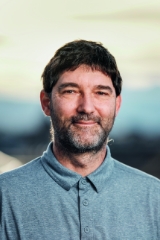In focus
Crash! Bang! And Break Things!
How does the world develop? Constantly or in leaps and bounds? It is one of the oldest scientific controversies, and it is far from settled. At the moment, catastrophic thinking seems to be gaining momentum again.

Wait, didn’t catastrophism seem to be over? Didn’t it have too many weighty opponents? Away with this misconception which was only intended to conceal biblical facts (the opponents said). Away with the idea that in the history of the Earth there have always been violent rumblings, catastrophic events that upset the beautifully balanced equilibrium.
At the end of the 18th century, naturalist Georges Cuvier called such rumblings “cataclysms”. He was the first to discover strange discontinuities in the fossil archive of life – what he dug up in the Paris Basin did not look like a continuous, undisturbed history of development. Throughout the Earth’s history, “void spaces” were apparently followed by moments of rapid change, and suddenly the Earth’s layers were full of new creatures. Phoenix from the ashes.
Scientifically founded catastrophism began with Cuvier, although the idea is much older as it can be encountered in the Bible at the time of the Deluge. References like these also meant the concept faced opposition right from the start. Most naturalists preferred to imagine the making of the Earth and the development of life to be beautifully constant, without brutal changes, that could only be thought of as “extra-worldly,” i.e. with God's influence. By the middle of the 19th century at the latest, the controversy was over – the gradualists had triumphed across the board, and with them the idea that nature develops slowly and steadily, gradually and never erratically. No disasters anywhere. Just moderated, orderly progress.
Subscribe to the uniAKTUELL newsletter

Discover stories about the research at the University of Bern and the people behind it.
Polycrises and collapsology
And now, at the beginning of the 21st century? Wherever you look, polycrises, a feeling that the end of the world is coming, wondering about what is going to be shaken up next. One example of this was a conference recently organized by the Literaturforum in Berlin’s Brecht-Haus (Brecht House) entitled “Nach der Ruhe vor dem Sturm. Über Katastrophismus, Kapitalocene und Kollapsologie” (After the quiet before the storm. On catastrophism, Capitalocene and collapsology". It makes sense to think of the Anthropocene, the man-made age of the Earth, together with capitalism, but collapsology has not yet gained a foothold in the German-speaking world, but try googling the word in French.
Magazine uniFOKUS

"Disruptions"
This article first appeared in uniFOKUS, the University of Bern print magazine. Four times a year, uniFOKUS focuses on one specialist area from different points of view. Current focus topic: "Disruptions"
More articles from this issue Subscribe to uniFOKUS magazineAnd coincidence or not: The idea of cataclysms has also been experiencing a surprising renaissance in geology for the past few decades. In 1980, the father-son team Luis W. and Walter Alvarez, the one a Nobel laureate in physics, the other a geologist, published new findings on an Italian Earth layer between the Cretaceous and the Tertiary. They had discovered a striking iridium anomaly in the sedimentary rocks, for both of them a clear indication of an asteroid impact 65 million years ago. The researchers put it this way: The impact of a roughly 10 kilometer-long rock had thrown enormous amounts of dust and soot into the atmosphere, causing global climate change. Result: Almost three quarters of all living creatures died out, including dinosaurs and large swathes of marine fauna. The idea has not been picked apart in the research community since then, in fact it was added to with other presumed catastrophes in the Earth’s history.
Quantum anarchy
And if you look beyond the history of the Earth, into cosmic dimensions? To the beginning of all things? If you ask even more fundamentally how this all came about, what then? What does the physicist say? Is the world evolving in a steady or “shattering” way? “Physics knows both: Processes that occur constantly and others that occur erratically,” says Michele Weber, Professor of Particle Physics. Phase transitions are a classic example of the latter. Weber’s work at CERN includes high-energy particle collisions; he is also interested in neutrinos that promise clues to undiscovered physics.
In fact, the study of particle physics, if you take it to the extreme, as at CERN, is virtually an antithesis to what is referred to as actualism that characterizes the earth sciences and says in simple terms that everything has always been the way it is now. And that you have to derive everything about the past from today’s observations, because the world used to be shaped by the same forces. Except perhaps, as we know today, for a meteor strike here and there.
About the person

Michele Weber
is Professor of Experimental Particle Physics and Director of the Laboratory for High Energy Physics (LHEP) at the University of Bern. He researches the fundamental particles and forces of the universe, including developing and conducting experiments at LHC/CERN near Geneva.
At CERN, on the other hand: You have quantum anarchy compared to today. Wild primeval times of matter. What happened in the first second of the world, whatever radical leaps there were in the hierarchy of forces: There were probably more violent transitions in the basic state of matter than in all the time since then – whether you imagine them to be “shocks” depends a little on metaphorical preferences. Then, things calmed down, “between one second and 370,000 years, not so much has happened cosmically,” says Weber. However, there were occasional banging effects in the aftermath. The formation of the first stars, still made entirely of hydrogen and helium, is important, for example. It was only inside that heavier elements such as carbon, oxygen and iron could form. And when these stars exploded again at some point, they also catapulted these elements far out into space. Yes indeed, we are stardust.
Economic cycles of the catastrophic
But the mother of all shocks was right at the beginning. The Big Bang: This idea, which has long seemed so obvious to us, first had to be “invented”. Bearing in mind the controversies surrounding catastrophism and gradualism in geology, it is quite ironic that a clergyman introduced the “big bang” into cosmology. In 1927, the Belgian theologian, Catholic priest and astrophysicist Georges Lemaître published an essay entitled “Un Univers homogène de masse constante et de rayon croissant rendant compte de la vitesse radiale des nébuleuses extra-galactiques” (“A Homogeneous Universe of Constant Mass and Increasing Radius accounting for the Radial Velocity of Extra-Galactic Nebulae”), which dealt with the idea of an expanding universe.
The “Annales de la Société Scientifique de Bruxelles” (The Annals of the Science Society of Brussels), in which the article was published, was hardly read by anyone of any rank in the international physics community. It was not until the mid-1930s that the community began to look at the consequences of Lemaître’s calculations: The fact that at the beginning of the expansion there must have been a “primordial atom” or “primeval atom”, an incredibly dense singularity. The establishment, still very gradualist, mocked the idea: The Big Bang is only known as such because the astrophysicist Fred Hoyle tried to denigrate the idea of an expanding universe that appears to arise from nothing. The result of his choice of words is well known: The steady state theory advocated by Hoyle, which does not allow sudden density changes in the universe, is off the table; the big shock, the Big Bang, on the other hand, is in the school books.
“Our world may have begun with tremors in the first second, but in the end everything will be pulverized.”
Michele Weber
Did the idea gain acceptance because it fell on socially fertile ground? If a century was disaster prone, it’s probably the twentieth century. Is it absurd to assume that gradualist ideas tend to gain momentum in quiet times? And, conversely, that ideas that tell the history of the Earth in an erratic course have more of a look-in if we are actually experiencing our world as shaped by shocks? As a physicist whose day-to-day work involves experimentally testing hypotheses, Weber does not focus on this kind of intellectual-historical perspective: The Big Bang Theory simply prevailed because measurements supporting the model had accumulated.
Unlimited expansion
Okay, and what do the experiments say about what happened before the Big Bang? Were there possibly many such creative shocks in the emptiness of space and time? Do they happen all the time, somewhere out there in the multidimensionality? A bubbling primeval quantum soup that constantly lets cosmic bubbles rise and finally lets them collapse again?
According to Weber, there is no answer to this question with the current state of basic research in physics. You could also say: The Big Bang cannot be reproduced, let alone what there was before it. At most, the particle chaos that followed. And this shows, in addition to astrophysical measurements: The expansion of the universe is likely to continue unchecked; we do not currently have any indications of a cyclical universe. But Weber also admits that there is still a lot to explore: “What do we actually know? Everything we see in stars and visible matter accounts for just 1% of the energy density. If you add the other known matter particles, the figure is 4%.” The rest is literally in the “dark” – physicists call it dark matter and dark energy.
Deeply rooted idea of the end of the world
Regardless of the great cosmic catastrophe stories, down here on Earth, the apocalypse seems to be becoming almost a self-fulfilling prophecy in times of global warming and biodiversity loss. “We live in apocalyptic times,” Georg Pfleiderer, Professor of Theology at the University of Basel, recently told the journal “reformiert”. In its history, mankind has probably never been so close to depriving itself of the means of life – once again, “a decisive time seems to have arrived”. Biblical writers also based their scripts on this fundamental feeling; the idea of the end of the world is deeply rooted in Christian thought.
“Resilience-building solutions that strengthen the balance are important.”
Heike Mayer
And it has once again become sociably acceptable. It is certainly striking that “global shocks” are gaining momentum in many contexts. The “crash” is incredibly attractive, especially when you see a situation as encrusted, blocked, hardly renewable. In addition, Cuvier had already noticed that, from a geological point of view, crises are also opportunities: Cataclysms are followed by phases of recovery, with a miraculous diversity of species. It is therefore no surprise that the current economy celebrates the buzzword “innovation” that ideally should come across as “disruption”. Move fast and break things, is a famous bon mot from Mark Zuckerberg. This idea goes back to the Austrian economist Joseph Schumpeter, who coined the term “Creative Destruction” more than a century ago, for him actually the defining characteristic of capitalism. Economic geographer Heike Mayer adds: “Schumpeter explicitly spoke of ‘explosions’ that upset the balance and, as a result, enable a development surge.”
Mayer, however, prefers a slightly different history of progress, as she finds it in her research. She mainly mentions “social innovations”, not the big abrupt technological change. It’s more about people getting together and finding out how to deal with a challenging situation in a co-creation. In contrast, she finds the disruption story “a little linear” and observes completely different dynamics, especially in rural areas. She would describe it more as a slow, creeping process: “Slow innovation”, which also doesn’t wipe out everything that’s been done before. Traditional knowledge does not lose its value that quickly. In this respect, when there is talk of innovation or disruption, the question of the sustainability of such developments inevitably arises.
Disruption or transformation?
Mainstream economy, on the other hand, continues to celebrate the creative, ingenious lone warrior, the entrepreneurial genius plowing through the markets with creative destruction. Such distortions are certainly attractive for shareholders, and stock market prices also reward this kind of progress. However, the negative effects of the disruptive were often ignored, says Mayer. It is only now that research is gradually also taking a look at the “dark sides” of innovation. At the moment, there is definitely a technocratic understanding of innovation, which to a certain extent comes in a religious disguise, with an inherent idea of “healing and saving”.
About the person

Heike Mayer
is Professor of Economic Geography at the Institute of Geography and Vice-Rector for Quality and Sustainable Development at the University of Bern. Her research focuses on urban and regional economic development with a particular focus on the dynamics of innovation and entrepreneurship.
Heike Mayer, on the other hand, wanted a less “shattering” view of economic development, moving away from innovation as a savior towards a transformative development with multiple actors working together. The challenges, not least of an environmental nature, are huge. In order to master these challenges, “resilience-creating solutions” that strengthen the balance are important, not those that make destruction a fetish.
Harmony and atomic dust
HierHere, Mayer echoes the ideas Weber propagates. Especially at CERN, where physics is systematically brought on a course of confrontation and particles are fired at each other with incredible amounts of energy in order to find answers to all the questions about the beginning and end of the universe (and the sometimes shocking in-between), the idea of harmonious collaboration is central, says Weber. “All the insights into the origin and evolution of the universe are based heavily on the collaboration of thousands of researchers from many different countries.” As things stand, however, research utopia has come up with more dystopian prospects. Michele Weber has good news and bad news about the ultimate catastrophe, the end of the universe. The bad news: “Everything will be pulverized, the universe will just drift further and further apart.” And end up as cooled atomic dust. The stars will burn out, everything will go dark. No regrouping, no new beginning, a lot of ashes, but no phoenix. He agrees that this is a “very discomforting” notion, but physics is pretty sure of the fate of the universe. “The measurements are clear, but the connections – we are not even coming close to understanding them.”
The good news is that “We still have thousands of billions of years to go before that.” Things will be a lot more shocking for us long before that: In around five billion years, the sun will burn up. So maybe it is a good idea to practice apocalypses a little beforehand, that is surviving them.